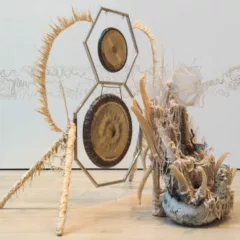For the past couple decades ever more museums have invited artists into their store rooms to curate exhibitions: in an early example, the RISD Museum invited Andy Warhol; MoMA asked Chuck Close and Scott Burden; and Fred Wilson has made a career of the practice. The results have almost always been interesting. Artists, of course, have their own questions of and approaches to objects and collections and it’s always enlightening to see familiar things in unexpected ways.
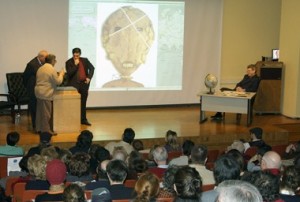 The Penn Museum’s recent invitation to Pablo Helguera (as part of Philagrafika ) was well-rewarded. Helguera spent time in the museum’s archives and discovered that museum director Froelich Rainey had made use of the quite new medium of television to bring the collections to public attention in the1950s. He hosted What in the World? in which a group of scholars and occasional celebrities were shown a museum object which they tried to identify; it was the first ever educational tv program. Helguera’s response took three forms: a recreation of the tv show’s format for a live event on Feb. 28th (above), a small gallery installation on view through April 11, 2010 and a book of stories about objects in the collection and the people behind them.
The Penn Museum’s recent invitation to Pablo Helguera (as part of Philagrafika ) was well-rewarded. Helguera spent time in the museum’s archives and discovered that museum director Froelich Rainey had made use of the quite new medium of television to bring the collections to public attention in the1950s. He hosted What in the World? in which a group of scholars and occasional celebrities were shown a museum object which they tried to identify; it was the first ever educational tv program. Helguera’s response took three forms: a recreation of the tv show’s format for a live event on Feb. 28th (above), a small gallery installation on view through April 11, 2010 and a book of stories about objects in the collection and the people behind them.
The What in the World? re-creation on Feb. 28th was hosted by current director, Richard Hodges with Helguera, artist Mark Dion and PMA curator, Joe Rischel as contestants. The objects they were given to identify were hardly from the museum’s best-known collections and a number of them were obscure indeed: Ainu prayer sticks, fetishes from Eastern Siberia, an apron from British Guiana. The participants were good sports and Dion’s habit of talking through his examination process (this is heavy, which means the wood isn’t completely dry so it’s probably 20th century) was particularly edifying for the audience.
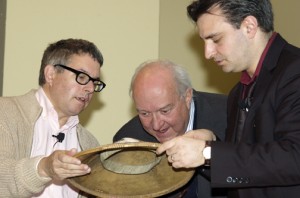
The gallery and book reveal Helguera’s interest in the history of the museum’s artifacts in the course of excavation and once they left their originating culture (or burial site) and came to the museum; some of them passed through the market first. While hardly a typical approach of archaeology and anthropology museums the Penn Museum looks at similar issues in its current exhibition about the excavations it sponsored at Ur (which I wrote about here).
The book, What in the World; A Museum’s Subjective Biography (which is available for purchase at the museum, ISBN -10:1-934978-28-0) is filled with stories about some of the obsessives, eccentrics and rogues responsible for five areas of the collection, and the gallery covers the same material with five objects on display, each with an associated video. The installation suffered somewhat from the fact that watching an 8-11 minute video projected on the wall above the objects case is awkward (all are available on Youtube, as are clips from the original television program ), but the videos themselves are great fun. Helguera has faithfully re-created the style of the original What in the World? complete with dry ice mist and haunting background music; and he has unearthed wonderful stories that include deception, theft, fakes and madness, which make for entertaining viewing and reading. Richard Hodges said he checked with Penn’s lawyer before allowing Helguera to publish the material, and I’m not certain whether he was joking.
There’s been a proliferation of recent interest in the role of the curator, accompanied by criticism that Harald Szeemann set a harmful example in the late 1960s by using the curatorial function as an art form itself. In that light it’s ironic that Helguera, working as an artist, took no more liberty with standard curatorial approaches than Fro Rainey had done sixty years earlier.
First Annual Print Invitational at Little Berlin

This first print invitational was organized by Tim Pannell, the only printmaker in the artists’ collective, Little Berlin, and I had a chance to talk with him at the opening. If many of the invited artists’ bios included R.I.S.D. it’s not a coincidence; that’s where Pannell studied. The twelve artists from across the country covered a broad range of what print-makers are doing these days from traditional uses of sreen printing and intaglio processes to mixed media and photographically-generated work. Both the work and the event were somewhat more sedate than the always lively, sometimes noisy openings at the gallery. I don’t mean anything negative by sedate; it’s just that most of the work was framed and sat quietly on the walls and none of it was edible.
I like prints, but I’m always asking why an artist did a work in multiples. Is the subject something that many people will want? Is there an audience that can’t afford the artist’s paintings (Durer sold engravings of commonly desirable subjects, such as madonnas, to finance his travels)? Is the image an effect that can only be done in drypoint, silkscreen, or whatever; or is the subject somehow connected with the medium and/or the multiplicity (one might say that Warhol’s off-register silkscreen was integral both to the visual effect and the subject)?
Vicky Chen’s series on the Port of Oakland employed the unusual technique of silkscreen on translucent gampi paper glued to wood, so the underlying wood grain becomes part of the image. Ports these days are filled with standardized shipping containers, and printmaking seemed an apt way to depict their global uniformity. Chen’s means were not easy to understand at first glance, but the results are subtle and something about her delicacy of line and use of space reminds me of Ben Shahn’s work.
Stella Ebner filled an entire wall with a grid of screen prints of a car lot along a highway strip. The only variation was the writing on the signage, an apt commentary on our culture of endless, interchangeable commercial appeals. Amelia Hankin used woodcut to create multi-color prints (variations of grey) of extreme subtlety. They gave the impression of landscapes, despite the fact that none of the forms was identifiable. She studied in Japan, and the sensibility comes through.
Serena Perrone exhibited a large, two-sheet mixed-media work that contrasted the boldness of a woodcut ship at sea with the delicacy of gold ink she used to draw in two female figures. Pannell’s own work was an homage to nineteenth-century wood engraving (cut on the end-grain of very hard wood, which enabled very fine lines). He gives historic tours of Philadelphia and, inspired by some of the mis-information he hears, produced the first in a planned series of fallacious histories: George Washington and Abraham Lincoln seated together, with the Statue of Liberty just visible through the window.
The print invitational, on view through March 27, also includes work by Kabuya P. Bowens, Kate Copeland, Juan Garcia, Morgan Hill, Fleming Jeffries, Alice Thompson and Tanya Ziniewic; it is also associated with Philagrafika.
Dead Flowers at Vox Populi
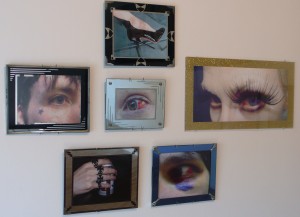
Dead Flowers, on view at Vox Populi through May 2 was curated by Lia Gangitano of PARTICIPANT INC, New York, where it will be exhibited May 9 – June 20, 2010. Inspired by the work of actor/director Timothy Carey, Gangitano assembled a variety of work by contemporary artists and those of the 60s-70s to explore the idea of the artistic underground and the shifting boundaries between underground and mass culture. The exhibition includes a recent documentary interview with Carey’s brother recounting how the actor made trouble for the nuns at grade school, among other stories.
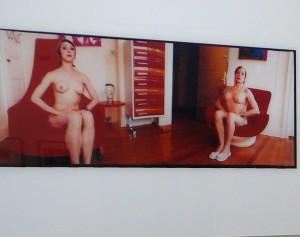
Gangitano’s underground is largely associated with the more flamboyant aspects of gay culture, so the exhibition is filled with false eye-lashes, heavy eye-liner and very high heels. While all of this was certainly underground in the 60s, who could have anticipated a broadcast television program called Queer Eye for the Straight Guy, much less same-sex marriage? Alvin Baltrop’s black and white Pier Photographs (1975-86) portray an insider’s view of gay coupling conducted out-of-doors in a then unfrequented area of New York. It’s hard to know what Baltrop’s intentions were, but the series records changing real estate as well as sexual values, as the far West Side has entirely succumbed to gentrification.
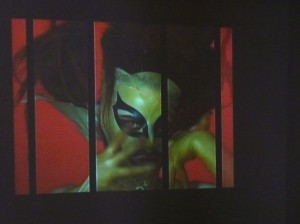
I’m not sure how Cynthia ‘Plaster Caster’s work fits in either with art or with the underground. Word circulated in the late 60s that a couple of rock groupies managed to get into the (mainstream) stars’ dressing-rooms with the intent of making plaster casts of their erect penises (and providing the necessary stimulation). The story was too outlandish to be made up, and now at Vox you can see the results yourself; although who but Cynthia can vouchsafe whether that is, indeed, a cast of Jimi Hendrix? As I told Andrew Suggs at the opening, penises without men attached hold little interest for me, but chacun à son goût. As to changing bounderies of the underground, not so long ago I saw photos of a middle-aged Cynthia in her kitchen (with casts) in the pages of some forgettable mainstream magazine.
Pat O’Neill at Screening
Pat O’Neill’s Horizontal Boundaries (2008, film transferred to video) is showing through May 2 at Screening, in Vox’s Space, and I found all 23 minutes mezmerizing. His collaged images move in changing rhythms that at times resemble a heartbeat, at others a racing train, with elleptical snippets of dialog that echo Beckett. O’neill has worked with the most mainstream of Hollywood filmmakers, but this is rigorous, exciting experimental film by a seventy-year-old who can still out-run his juniors.


